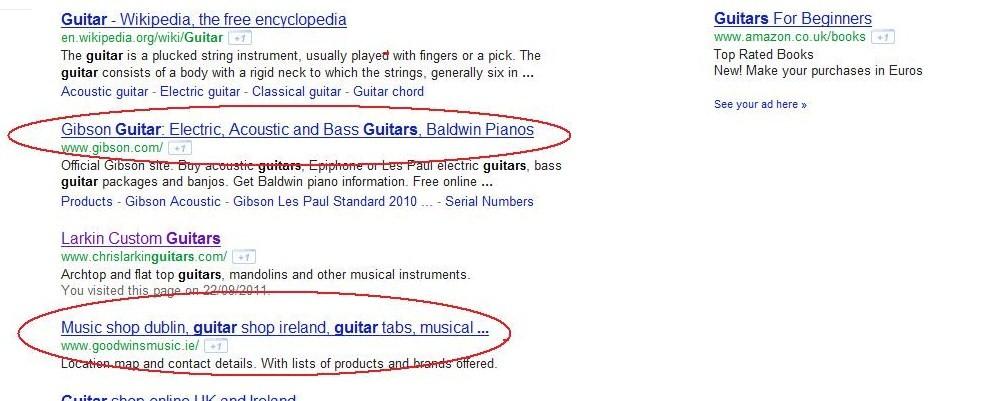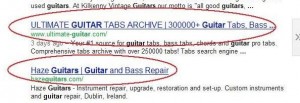I recently had the task of doing some major on page optimisation modifications for a client and I thought it might be a good idea if I shared a few insights to the importance of having good quality on page optimisation.
It is estimated by some SEO experts that on page optimisation factors account for roughly 30% of the important criteria that govern any SEO campaign. The other 70 % they say goes towards your off page factors and in particular your link building strategies.
On page SEO factors are made up of all the things you can do to the content of your website that have a direct impact on your sites performance and its overall relationship with the search engines. Some of the most important on page factors to be aware of include Page Titles, URL’s, Meta Tags, Meta Description Tags, Headings, Body & Text, Image Alt Tags, internal links and various other components.
From a keyword optimisation perspective the single most important component of your on page SEO procedures is your title tags. This is mainly due to following reasons:
When the search engines come crawling to index your site their first port of call is to inspect your title tags. The content contained within your title tags give search engines the clearest indication of what a particular page is about. Search engine crawlers and spiders can and do scan other elements of your page such as Meta Keywords, Alt Tags and HI and H2 Tags. But they don’t have the significant level of influence that title tags have when it comes to determining how a search engine choose to retrieve information for a search query.
When you search on a term the first thing the first thing the search engines will focus on in their information retrieval process will be the title tag. A title tag shows up in a SERP as a highlighted as a click able link. Having a great title tag can make a huge difference in terms of the traffic your page is generating. If your title tag is dull or boring or conveys little or no relevance to the search query than my guess is you’re missing the opportunity to convert important traffic. You should view your title tags as the quintessential calls to action to entice users to your website. You’re essentially opening the door by having a good title tag in place.
Some tips on how to structure and organise your title tags:
You should ensure that every page no matter how large should have its own unique title tag.
The length of your title tags is a very important factor. Google will only display up to 65 characters (including spaces) in the description of your title tags.
It is vital to include your most important keywords and keep them as close in sequence to the start of the title tag as possible. For example if you had 5 prominent keywords in mind for a particular page let’s say “Dublin Classic Guitars”, “Gibson Guitars”, “Fender Guitars”, “Electric Guitars”, and “Acoustic Guitars”. But out of those 5 you consider Dublin Classic Guitars, Gibson Guitars and Fender Guitars to be your up-most important. In this case you would keep those particular keywords in a sequence as close to the start of the title tag as possible.
Dublin Classic Guitars | Gibson Guitars | Fender Guitars | AceGuitarWorld.com
Notice in the above example the sequence Dublin Classic Guitars | Gibson Guitars | Fender Guitars | represents only 58 characters and is within the Google’s 65 restriction limit. Also notice that the name of the website “AceGuitar-World.ie” is at the end of the title tag sequence and as a result won’t be displayed in a search engine result.
This is a matter that can be decided by what is more important. If for instance brand awareness was an important goal you may think it more important to include the name of the website at the start of the title tag sequence. But that would mean you would have to sacrifice the display of one of your core keywords in the search engine results if you structured your title tag this way. If however pure SEO results and getting ranked on the first page is your top priority and is more important to your website than brand awareness you should structure a title tag the way it is in our example.
You should also structure your title tags in such a way as to try and convey a call to action. Notice the structure in our example once more:
<title> Dublin Classic Guitars | Gibson Guitars | Fender Guitars | AceGuitar World.com </title>
If I was a guitar enthusiast (in which case I am) with this type of title description I couldn’t click the link fast enough if I saw it for real. The use of the pipe symbol (| | |) and the words contained within them |Gibson Guitars | Fender Guitars | just look fantastic in a SERP, to my eyes anyway.
Look at the image below. If “guitar tabliture” was my search query and i was presented with this search result i would be very inclined to click on the link because the call to action is strong a very appealing to me. Similarly the same would apply with the link below. If my search query was for “guitar repairs” and i saw this link on the first page i might be very inclined to click on this link.
A strong but simple call to action in your title tag combined with a good meta tag description is a winning combination as far as your attempts to gain clicks is concerned.
You should always repeat keywords which you have included in your title tag in the URL, meta keywords tag, headings tags, Alt tags as well as the body of text on your page. These techniques coupled together with a strong title tag will help emphasise to the search engines the relevancy of a page to a particular search query.
In my next post I will talk in more depth about the significance of employing theses other On Page optimisation factors.







Connect With Us